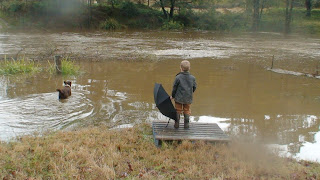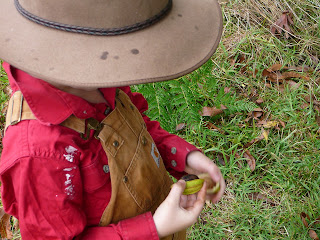Pages
Sunday, September 8, 2013
Friday, March 16, 2012
Our new bull comes through
Having paid a fair bit for a new bull theres's always a niggling doubt in your mind about whether you've bought a dud. On a big farm that's a worry but on a small farm with only one bull, its a disaster. So it is that we've been waiting more then ten months for our new bull "Mostly Angus" to come through.
This week we've seen his first calves and we couldn't be happier.
 |
| First new calf from Mostly Angus |
 |
| Little fellow hidden by his mum in the grass |
 |
| Mostly Angus himself a proud father |
 |
| All the family |
Sunday, June 12, 2011
Flooded in


So much rain!
Over 210mm in the last two days. It looks like we're here for a few days until the water over the road falls a bit.
The water came up about four feet over night. We went out at 5 o'clock to feed the cows at Gumarm and the creek didn't look too high. By 7 o'clock this morning it was a whole different story. The water had come up and the creek was flowing fast.
The cattle are all happy and not at bothered by water all around.
Still, we have power and phone and plenty of food so it could be worse.
Tuesday, April 26, 2011
I love the autumn
 Autumn is a wonderful time at Geebung. Everything starts to move into reds and yellows. The pecans are picked and the trees go from froggy green to a strong yellow on their way to becoming the bare trees that we live with most of the winter.
Autumn is a wonderful time at Geebung. Everything starts to move into reds and yellows. The pecans are picked and the trees go from froggy green to a strong yellow on their way to becoming the bare trees that we live with most of the winter.The cattle start putting on thick winter coats and generally take a lot more interest in us as people who might have something tasty to supplement the tinning supply of pasture.
Last week was our Australian Certified Organic (ACO) audit, which we passed without too much trouble. The ACO audit process is pretty exhaustive but it gives me an hopefully you a lot of comfort to know they're making sure that "certified organic" means something.
The idea is that our product is traceable all the way from the farm through to processing, packaging and retail.
These audit trails give you a high level of assurance that the food we grow is produced without use of synthetic chemicals, GMOs and food additives and with a focus on soil health, animal welfare and best environmental practices, as required by the Australian Certified Organic Standard (available for free via http://www.bfa.com.au/ ).
Our picking efforts
I confess our picking efforts have been pretty modest this year. The cockatoos and demands on our time for other things have meant we haven't picked anywhere near the number of nuts we would like to.
Friday, April 15, 2011
Veal from Geebung

Our veal is Angus which is different from most veal you are exposed to. Most of the veal that you eat is a diary industry by-product. In that sense the veal is usually Holstein-Friesian veal.
By taking a higher quality meat breed and harvesting younger we think you get a superior product with better flavour. In most cases our veal is at least 5 months old, usually more like 6.
The calf will have been feeding on its mother's milk for all its early life but has started to eat some pasture. Our pasture is a mixture of native grasses (including kangaroo grass themeda triandra wallaby grass, white top austrodanthonia and red grass bothriochloa macra) , clover, ryegrass, paspalum and kikuyu grass.
We read with concern about the idea that calves could be deprived of feed for up to 30-hours as part of the proposed new Land Transport Standard. For us this is cruel and is not needed nor would we accept that as a way we deal with our animals.
Our calves are with their mothers until they are collected at about 5.00 am then they travel for less than an hour and are usually processed on arrival at the abattoir. We believe this ensures that any stress is kept as low as possible.
The ACO standard on these matters is clear. We always transport our animals in a way that is respectful and designed to minimise stress on the animal.
Generally we are looking for a cleaned carcass, which is smaller than most of the veal that is found in the commercial marketplace but is between 80 and 110 kg. We are looking for a supple texture and extreme tenderness. We think the natural flavours are attributed to having been milk fed as well as from grazing in natural pastures that have been farmed organically over a great many years.
Our animals grow in a stress free environment and are happy and healthy.
The product we provide is of consistent quality we love working with Grant and Laura from Feather and Bone because they are lovely people to work with and because we think we share a lot of values with them.
Nut season

The pecans are getting close to being ready to pick. The air is thick with white cockatoos who are enjoying my pecans!
The pecan, Carya illinoinensis, is a great tree and is well suited to organic farming. Our pecan groves are managed both for nuts and for grazing of livestock. This is called “agroforestry” and involves growing trees on the same unit of land as crops or livestock. The idea behind agroforestry is to derive both economic and ecological benefits two key goals of sustainable agriculture. We graze fat, happy Angus cattle between the rows of pecans.
Looking after pecans
Our pecans are organically grown, handpicked ripe, and then dried. They are not processed in any way. They keep well at a cool room temperature so long as they remain in the shell. Shelled Pecans absorb odours and go rancid quickly, especially in hot weather. Pecans can be frozen, thawed out and frozen again, if necessary. Pecans are great as a peel-and-eat snack and their distinctive taste is a great addition to a salad or to almost any meal. Pecans can be toasted to enhance their flavour. There are two ways to toast nuts: in a hot oven for about seven minutes, stirring them from time to time to prevent burning, or on the stove top in a heavy pan. Toast on medium to high heat, stirring frequently. As soon as nuts begin to smoke a little, they release their aroma and are ready. Be sure to let them cool before chopping.
Native Americans
Long before Europeans arrived in North America Native Americans were using pecans as an important food source. Indeed, the native life and their nomadic existence revolved around the pecan tree and its life-sustaining nut. Archaeologists have shown a major concentration of campsites in the immediate areas of the heaviest native pecan stands.
 Native Americans came in great numbers and concentrated in the river valleys in the fall to harvest pecans. Hunting and all other activities took place from their pecan valley headquarters. In some communities these Native Americans depended on the pecan as their major food resource for about 4 months of the year.
Native Americans came in great numbers and concentrated in the river valleys in the fall to harvest pecans. Hunting and all other activities took place from their pecan valley headquarters. In some communities these Native Americans depended on the pecan as their major food resource for about 4 months of the year. Many varieties of pecans (there are over 1,000) are named for Native American tribes, including Cheyenne, Mohawk, Sioux, Choctaw and Shawnee.
Sunday, April 10, 2011
Seans Panaroma-Bondi
Neally ate my own calf the other night at a great dinner at Sean's. Geebung veal was on the menu,...opted for the aged grass feed sirloin form Tasmania,....bloody yum.
Subscribe to:
Posts (Atom)





